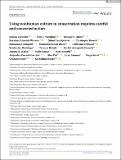Files in this item
Using nonhuman culture in conservation requires careful and concerted action
Item metadata
| dc.contributor.author | Carvalho, Susana | |
| dc.contributor.author | Wessling, Erin G. | |
| dc.contributor.author | Abwe, Ekwoge E. | |
| dc.contributor.author | Almeida-Warren, Katarina | |
| dc.contributor.author | Arandjelovic, Mimi | |
| dc.contributor.author | Boesch, Christophe | |
| dc.contributor.author | Danquah, Emmanuel | |
| dc.contributor.author | Diallo, Mamadou Saliou | |
| dc.contributor.author | Hobaiter, Catherine | |
| dc.contributor.author | Hockings, Kimberley | |
| dc.contributor.author | Humle, Tatyana | |
| dc.contributor.author | Ikemeh, Rachel Ashegbofe | |
| dc.contributor.author | Kalan, Ammie K. | |
| dc.contributor.author | Luncz, Lydia | |
| dc.contributor.author | Ohashi, Gaku | |
| dc.contributor.author | Pascual-Garrido, Alejandra | |
| dc.contributor.author | Piel, Alex | |
| dc.contributor.author | Samuni, Liran | |
| dc.contributor.author | Soiret, Serge | |
| dc.contributor.author | Sanz, Crickette | |
| dc.contributor.author | Koops, Kathelijne | |
| dc.date.accessioned | 2022-01-10T16:30:12Z | |
| dc.date.available | 2022-01-10T16:30:12Z | |
| dc.date.issued | 2022-01-06 | |
| dc.identifier | 277356577 | |
| dc.identifier | f17261c5-6342-4f5d-9c24-df6ad42e222e | |
| dc.identifier | 85122373285 | |
| dc.identifier | 000739420500001 | |
| dc.identifier.citation | Carvalho , S , Wessling , E G , Abwe , E E , Almeida-Warren , K , Arandjelovic , M , Boesch , C , Danquah , E , Diallo , M S , Hobaiter , C , Hockings , K , Humle , T , Ikemeh , R A , Kalan , A K , Luncz , L , Ohashi , G , Pascual-Garrido , A , Piel , A , Samuni , L , Soiret , S , Sanz , C & Koops , K 2022 , ' Using nonhuman culture in conservation requires careful and concerted action ' , Conservation Letters , vol. Early View , e12860 . https://doi.org/10.1111/conl.12860 | en |
| dc.identifier.issn | 1755-263X | |
| dc.identifier.other | RIS: urn:3DF1B7A777C76B19DA8A0446FE08752F | |
| dc.identifier.other | ORCID: /0000-0002-3893-0524/work/105956629 | |
| dc.identifier.uri | https://hdl.handle.net/10023/24631 | |
| dc.description.abstract | Discussions of how animal culture can aid the conservation crisis are burgeoning. As scientists and conservationists working to protect endangered species, we call for reflection on how the culture concept may be applied in practice. Here, we discuss both the potential benefits and potential shortcomings of applying the animal culture concept, and propose a set of achievable milestones that will help guide and ensure its effective integration existing conservation frameworks, such as Adaptive Management cycles or Open Standards. | |
| dc.format.extent | 343375 | |
| dc.language.iso | eng | |
| dc.relation.ispartof | Conservation Letters | en |
| dc.subject | Adaptive Management | en |
| dc.subject | Animal culture | en |
| dc.subject | Conservation policy | en |
| dc.subject | Open Standards | en |
| dc.subject | Target definition | en |
| dc.subject | QL Zoology | en |
| dc.subject | T-DAS | en |
| dc.subject.lcc | QL | en |
| dc.title | Using nonhuman culture in conservation requires careful and concerted action | en |
| dc.type | Journal article | en |
| dc.contributor.institution | University of St Andrews. School of Psychology and Neuroscience | en |
| dc.contributor.institution | University of St Andrews. Centre for Social Learning & Cognitive Evolution | en |
| dc.identifier.doi | https://doi.org/10.1111/conl.12860 | |
| dc.description.status | Peer reviewed | en |
This item appears in the following Collection(s)
Items in the St Andrews Research Repository are protected by copyright, with all rights reserved, unless otherwise indicated.

